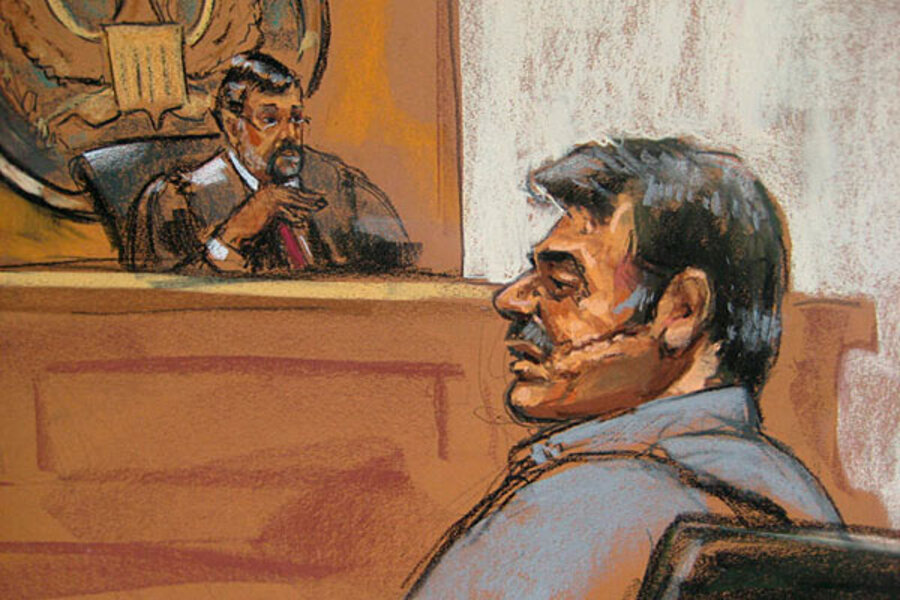Assassination plot: New twist in Iran's secret war with US?
Loading...
| Washington
From its beginnings, the Islamic Republic of Iran has struck its enemies – even once on American soil, in a suburb of the US capital – when it felt mortally threatened.
So with Iran increasingly isolated from the international community, with tumult in the Middle East foiling Iranian designs of expanded regional influence, and with Western sanctions and covert intelligence actions taking their toll, perhaps it should not be such a surprise that elements of the Iranian regime would dream up a sensational plan for striking back and evening up the scorecard.
The foiled plot the Justice Department divulged Tuesday, in which officials of Iran’s Revolutionary Guards Corps planned to have the Saudi ambassador to Washington assassinated on US soil, strikes most Iran experts as the work of a regime that feels cornered and desperate.
In that sense, the alleged plot reflects the mindset and survival strategy of a regime that has reached far to intimidate and cut down its enemies since its founding in 1979.
Some national security analysts initially described the plan as laid out by US officials Tuesday as “unprecedented” over its most brazen element: It was to have been carried out on American soil, under one scenario through a bombing at a Washington restaurant.
But it may be that the masterminds of the foiled plot were harking back to 1980, when the fledgling Iranian regime – obsessed with the threat of a counterrevolution that would bring down the Ayatollah Khomeini – took what would become a covert war with the regime’s enemies to a quiet street in Bethesda, Md., just over the state line from Washington.
In July of that year, a radicalized American Muslim, working on the orders of a contact he later described as an operative of the Iranian government, went to the Bethesda home of Ali Akbar Tabatabai, a former spokesman for the Iranian embassy who had become a high-profile critic of Ayatollah Khomeini and the revolutionary regime, and shot him dead.
The American, Dawud Salahuddin, an African-American who had changed his name from David Theodore Belfield, fled the country and is still believed to reside near Tehran.
That was the only time Iran was known to have struck on US soil, but in subsequent years it frequently acted in Europe against former Iranian officials it viewed as threats.
Iran developed a different pattern for hitting at the US and other enemies – most notably Saudi Arabia, but also Israel. It used of proxies like Hizbullah in Lebanon. The attacks on the Marine barracks in Beirut in 1983 and on the Khobar Towers US military housing in Saudi Arabia in 1996 are both attributed to Iran through proxy operatives.
More recently, US officials believe Iran has worked directly through its own forces, in particular the Revolutionary Guard Corps cited Tuesday, to attack US forces and interests in Iraq and in Afghanistan.
Some critics of US policy toward Iran say US administrations, stretching back as the Reagan administration, have set a dangerous pattern by leaving Iranian actions unanswered.
But others point to a list of recent actions attributed to Western and US-allied intelligence agencies as part of a covert war that has seen victories and setbacks on both sides. The war has included the kind of blows that the Iranian regime would interpret as aimed at its very existence.
Among those actions are the so-called Stuxnet worm, the case of industrial sabotage last year that set back Iran’s nuclear program. Also, during the past four years at least four top Iranian nuclear scientists have been killed – in one instance by poisoning – while a fifth narrowly escaped a bombing attack.
Iran has accused Western operatives, specifically from Israel and the US, of carrying out these attacks, but both the US and Israel have remained mum on their involvement. Many officials from countries friendly to the US have asserted that the acts are the work of Israeli operatives assisted by the US.
On the scorecard of a 30-year covert war, the deadliest attacks would seem to be on the Iranian side, but the most recent ones would seem to stack up on the side of its opponents.
From that perspective, the alleged plot to assassinate a Saudi diplomat a few blocks from the White House may have been the attempt of someone – at what level we don’t yet know – to even the score.





